How do you deal with the scorching heat of summer? Surrounding oneself with cool-looking items to make a place look cooler and thus feel cooler, is a common practice around the world during summer. Japan is no exception. Some of the most popular traditional summer items—used long before the air conditioner was invented—are furin (wind chimes), sudare
(bamboo blinds), tatami
(grass mats), sensu
(hand-fan) and tenugui
(facecloth) adorned with summer patterns.
It’s a tradition here to hang out furin (pronounced “foorin”) during summer and enjoy the tinkling sound when a gentle breeze blows. Today we’ll take a look at one of the largest wind chime seasonal markets in the country. (Continued after Japanese summary).
Summer Means Bring Out the Wind Chimes
Every year in July, Kawasaki Daishi temple in Kawasaki City (Kanagawa Prefecture, Japan) holds this huge, popular wind chime fair.

The market is held within the span of five days. We like to go there in the morning, but even then it’s already crowded.

On the way inside the temple grounds there are stalls lining up the street. Since wind chimes are a summer tradition they are sold in shops starting June (above). They usually cost anywhere from JPY 350 to 2,500.
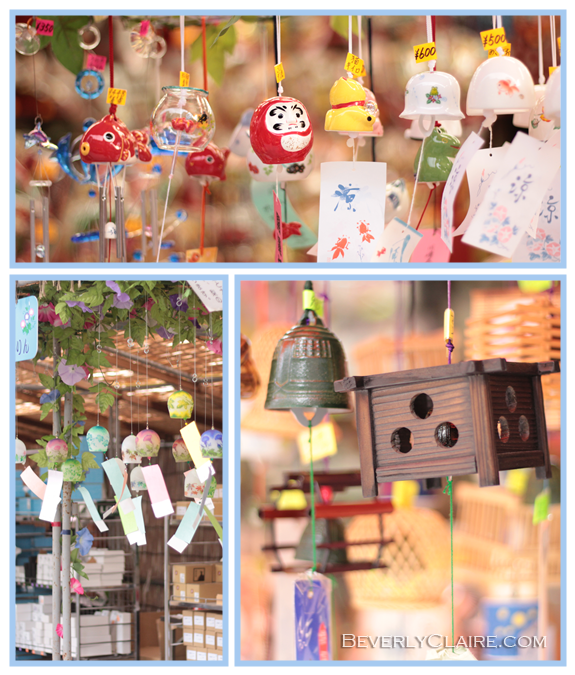
There is usually a difference in design and quality between the mass-produced chimes (above, top photo) and the hand-crafted, more expensive ones sold at the fair (above, bottom two photos).
Now let’s have a closer look at all the little beauties sold inside the temple grounds!
Something for Everyone
Wind chimes from all over the country are available for purchase; there were 900 kinds (ceramic, glass, metal, bamboo, crystal, etc) and over 30,000 pieces for sale. There are dozens of shops and tons of designs. I can’t show them all here but here are some favorites.

A daruma wind chime 川崎大師オリジナルの厄除だるま風鈴
To start, here’s a wind chime designed especially for the Buddhist temple that held the fair. It shows a daruma or Dharma doll and meant for yakuyoke, a charm to ward off bad luck or danger.
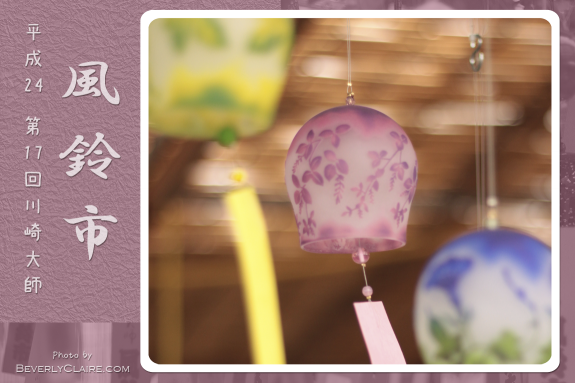
Floral-patterend chimes 長野の諏訪ガラス風鈴
Suwa glass wind chimes from Nagano Prefecture. I love the milky glass base and floral leaf patterns.

Pretty floral fans on a crystal clear base
A glass wind chime called Kitakata-makie, from Fukushima Prefecture.

Pottery wind chimes 福岡県産の上野焼風鈴
Agano-yaki wind chimes from Fukuoka Prefecture.

Pretty in white and pink 兵庫県産の神戸風鈴
Wind chimes from Kobe, Hyogo Prefecture. Love the sweet pastel colors; kinda reminds me of ice cream 🙂 Which makes a lot of sense because Kobe is famous for its desserts.

Glass wind chime from Aomori 青森県産の津軽びいどろ風鈴
Tsurugaru-biidoro wind chimes from Aomori Prefecture.

Smiling wind chime from Chiba 千葉県産の九十九里浜うみおと風鈴
Kujukurihama-umioto wind chime from Chiba Prefecture in Japan. I like the cute, smiling face of this one 🙂

Kitakata glass wind chime 福島県産の喜多方風鈴
Another Kitakata wind chime from Fukushima Prefecture in Japan. Wind chimes here are usually hung out in summer but with this cherry blossom pattern, I’d like to bring it out by spring!

Pottery wind chime 愛知県産の常滑焼風鈴
Tokoname-yaki fuurin (Tokoname earthenware wind chime) from Aichi Prefecture.
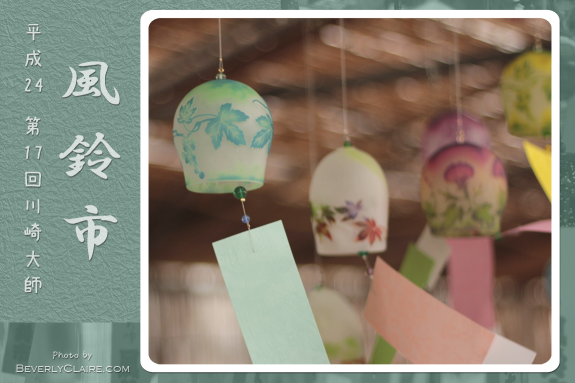
Suwa wind chime from Nagano 長野県の諏訪風鈴
More Suwa wind chimes from Nagano.
As you can see, my favorites are all rounded wind chimes, but they actually come in all shapes and sizes.

Myouchin wind chime from Hyogo Prefecture 兵庫県の明珍(みょうちん)風鈴
The glass and crystal ones have great textures and cuts, too.
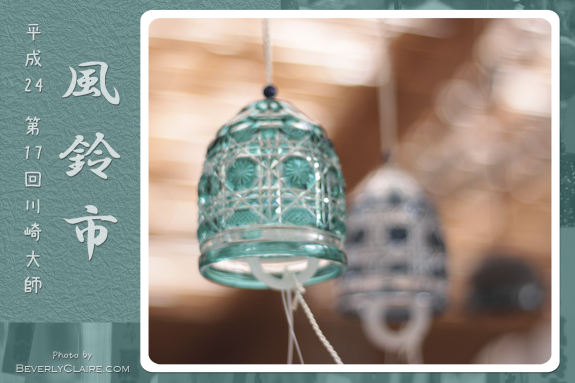
Satsuma-kiriko wind chime from Kagoshima Prefecture 鹿児島県産の薩摩切子風鈴
Prices range from JPY 1,200 to up to over JPY 20,000! These are all lovingly hand-crafted, hand-made chimes by artisans, so I could understand how some are simply a lot more expensive than the average factory-produced chime that can be bought at a hyakuen (dollar) store.
Wind Chime for the Heart
We purchased one wind chime from Fukushima to hang in our living room. But even if you don’t intend to buy anything, I highly recommend this market to anyone who loves traditional Japanese designs. Just looking at them is a way to enjoy a happy summer tradition.
Back in the days when there were no electric fans or air conditioners people would hang chimes above their windows, and when a breeze blows the chime emphasizes the coolness of the wind. I think it’s a lovely way to get through the sometimes stifling heat of summer.
When to Go
The market is usually held on the third Wednesday (and runs till Sunday) of July each year. Click here to check out the official page for the dates and schedule of the fair.
They serve iced tea for free to fair-goers. When you see it, go get yourself a gulp. We decided to “come back to it later, after taking photos”) but when we went back to the stall near the entrance the tea was all gone! So when you spot it, drink up! 🙂
How to Get There
Kawasaki Daishi is an 8-minute walk from Keihin Kyuko’s Kawasaki Daishi station. You can change to the Keihin Kyuko train at Kawasaki station, which is accessible from Tokyo via the JR Tokaido-Honsen line or Keihin-Tohoku line.
Click here for directions in English. アクセス方法はこちら。
I Would Love to Hear from You!
So, what do you think of this article? Please share your thoughts and opinions in the Comments section below.
この記事についてのご意見・ご感想を是非、お聞かせください!コメント欄↓に書きこんで頂けると幸いです!
External Links
Kawasaki Daishi Fuurin Ichi – official page for the fair, with the dates and schedule of performance (Yep, there is a traditional dance performance on one night during the fair).
Kawasaki Daishi Official Site – all the temple info. English version is also available.
Related Reading 関連書籍
Related Gifts
Postcards of photos taken at Kawasaki Daishi are available in my gift shop. Customize with your own text and message!




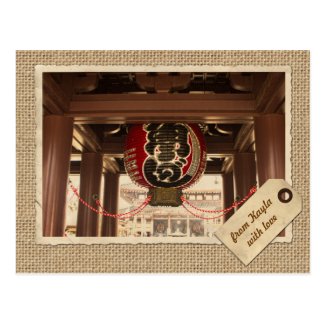
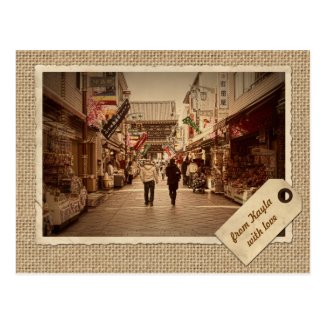
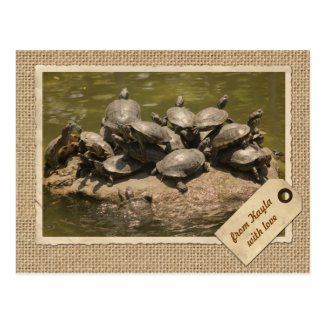










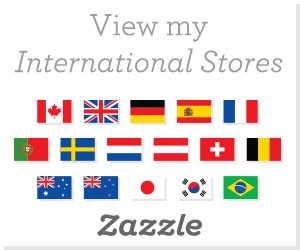













 Welcome! Whenever I plan an itinerary I try to read the first-hand account of others. Why? Because it helps! This site contains not just detailed accounts of my experiences, but also things I learned along the way. Hopefully they'll be a source of information (and inspiration?) to you. Enjoy!
Welcome! Whenever I plan an itinerary I try to read the first-hand account of others. Why? Because it helps! This site contains not just detailed accounts of my experiences, but also things I learned along the way. Hopefully they'll be a source of information (and inspiration?) to you. Enjoy!
beautiful pics! love the Suwa glass wind chimes from Nagano. used to hang out furin in nagoya but not anymore, here. makes me nostalgic…
Hey Han! Thanks, glad you like the pics. It’s always fun looking at all the designs. Did you have a ceramic wind chime before? I got one as a present (shaped like a Sumo dude) from a friend in Nagoya, but it fell and broke in two. I glued it back together but am now afraid to hang it…
風鈴の音色は涼しさを感じますね。また、ガラスの風鈴はそれ自体が透き通った清涼な気分にさせてくれます。
これから猛烈な暑さに突入するので、風鈴で少しでも涼しく過ごしたいです。
Are the sticklike Myouchin wind chimes made of ceramic or metal? Probably the latter huh?
Re: the tea, I always “grab now” when at big events. Things are bound to run out.
They’re made of metal, iron in particular. My research revealed that they’re made by a family of metal craftsmen in Hyogo Prefecture, the current one being Myouchin the 52nd. It seems he’s training his son to be #53 🙂 The wind chime is actually made of a collection of 火箸 “hibashi” or metal chopsticks used to handle charcoal, often used during traditional tea ceremony. I guess somebody found that when the chopsticks are suspended and clink together, the sound they make is pleasing to the ears 🙂 It’s said Stevie Wonder loved the sound. And that Sony uses it to test the sound/recording quality of microphones. Ha! I learned something new today, thanks for the good question! 🙂